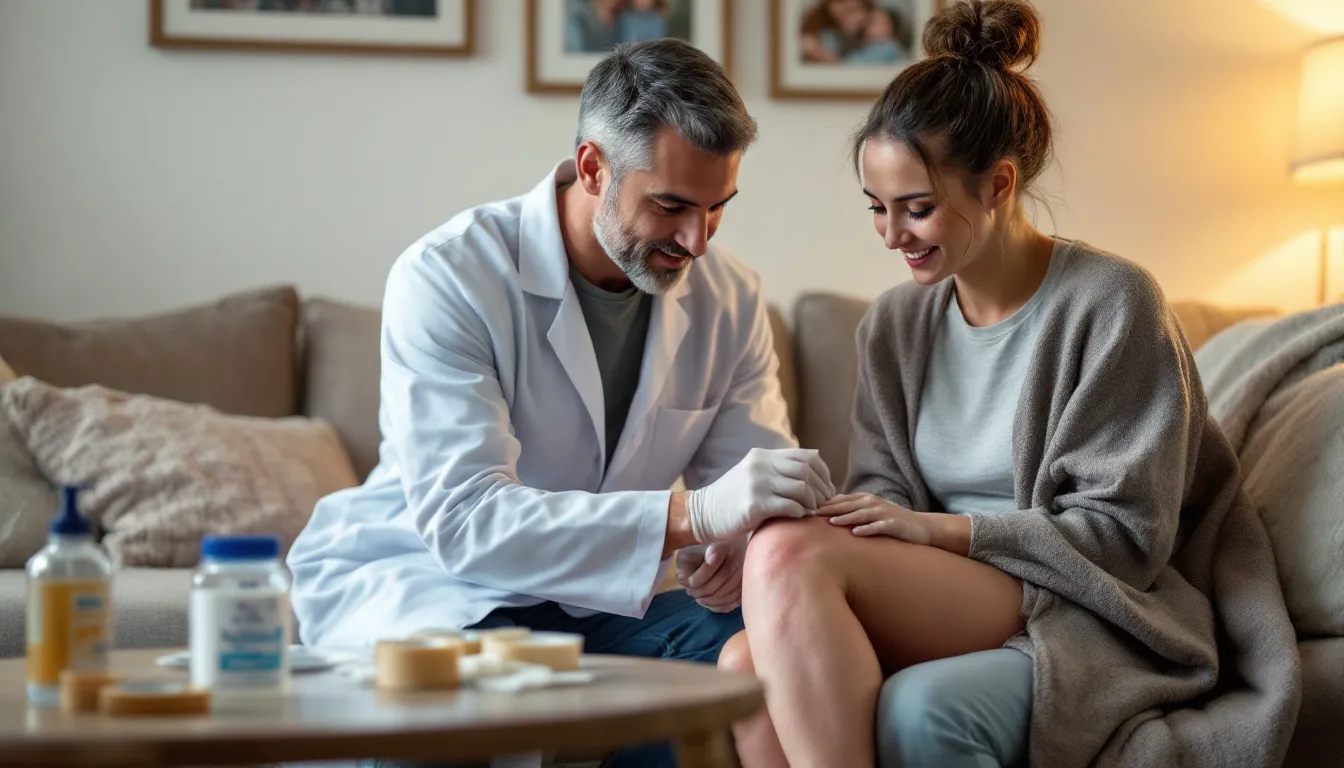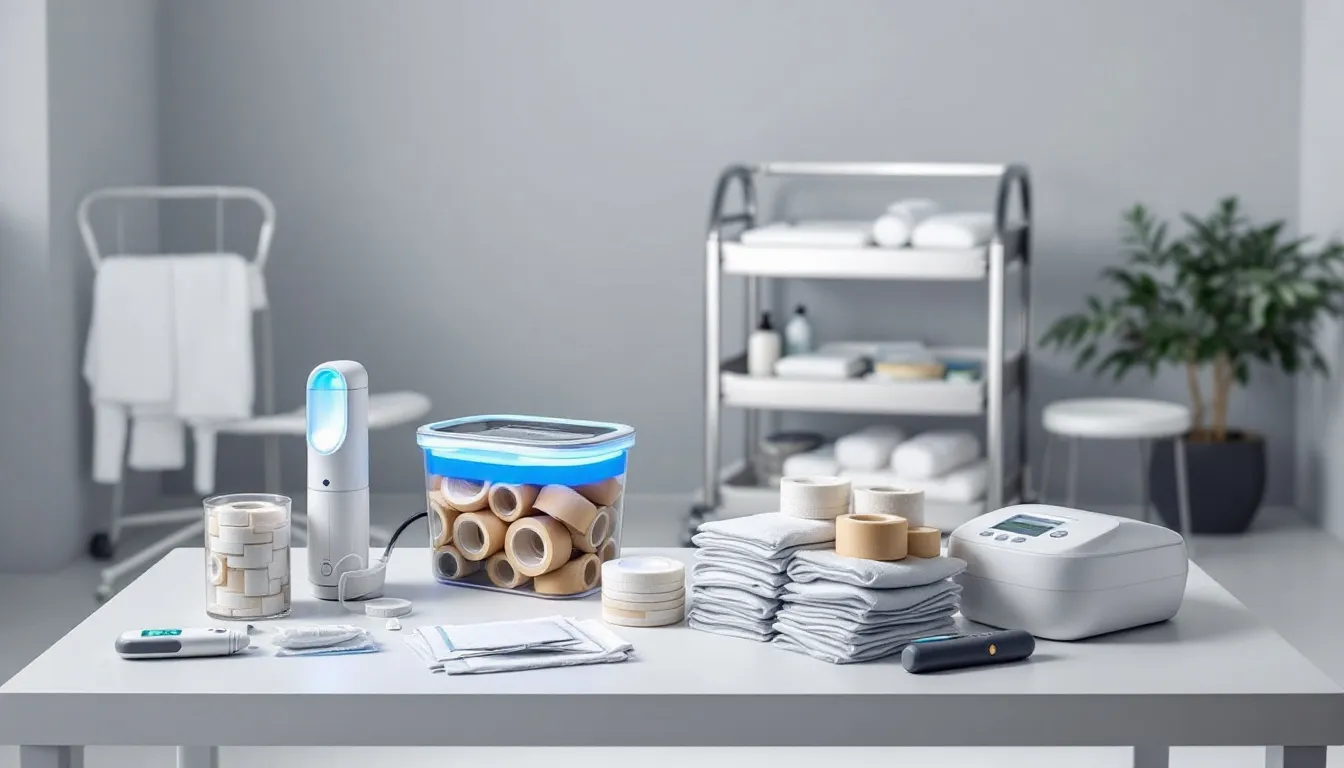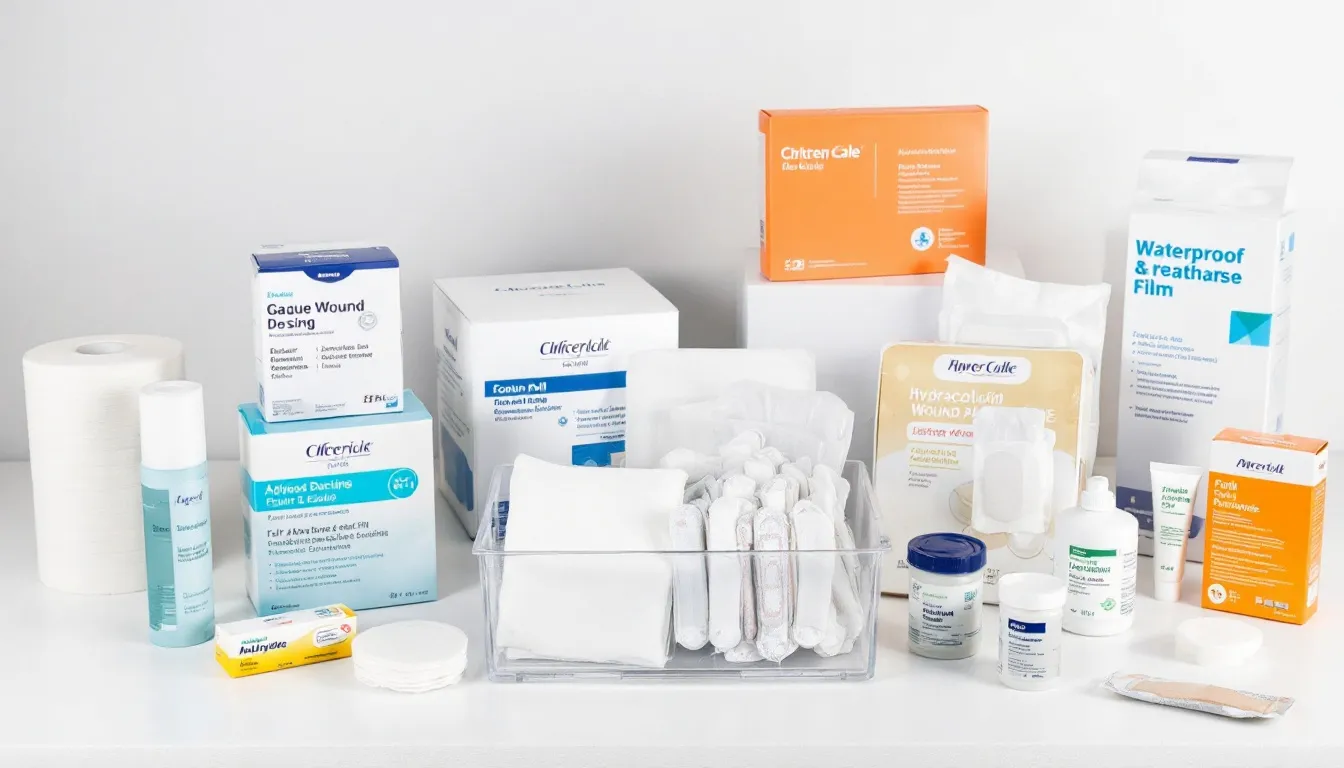For home health agencies, effective wound care products are essential to enhance patient outcomes and simplify care. This article delves into specific products like moisture-balancing dressings, biologic grafts, antimicrobial solutions, and absorptive dressings, explaining why these make a difference in wound care for home health agencies: what products make a difference.
Key Takeaways
- Home health wound care faces significant challenges, including patient non-compliance and the complexities of independent care management.
- There is a rising demand for advanced, portable wound care products that enhance patient autonomy and comfort while facilitating effective healing.
- Biologic products, such as amniotic membrane wraps and bioengineered grafts, are essential for supporting natural healing processes and improving patient outcomes in home health settings.
Unique Challenges of Wound Care in Home Health

Wound care in home health settings presents a myriad of unique challenges that healthcare providers must navigate. One of the primary obstacles is patient non-compliance due to a lack of understanding of the importance of wound care. Educating patients about their critical role in the healing process can empower them, fostering greater independence and responsibility. However, this is easier said than done, as home health nurses often face time-consuming workflows that limit the number of patients they can manage effectively.
Another significant challenge is the independent nature of fieldwork, which can hinder the enforcement of wound care protocols and maintain independence. Nurses may not always be comfortable using advanced wound care products, impacting patient outcomes. Moreover, accurate wound measurement is crucial, as improper methods can lead to prolonged healing times and increased patient loads.
With the expected rise in chronic wounds, these challenges are set to become even more pronounced. Effective wound care is critical, especially for wound patients returning home from healthcare facilities who are particularly vulnerable to wounds and pressure injuries. A wound care specialist can provide essential guidance in managing these conditions.
Rising Demand for Portable and Effective Wound Care Products

The demand for portable and effective wound care products is on the rise, driven by the increasing need for convenient and user-friendly solutions in home health settings. Modern wound care products aim to simplify the management of injuries at home, making it easier for patients and caregivers to handle wound care with minimal professional intervention. This trend towards self-care has spurred innovations in wound care technology, resulting in products that enhance patient autonomy and reduce the need for frequent healthcare provider visits.
Advancements in materials technology have led to the development of more effective and easy-to-use wound care products, including bandages. Home health nurses prioritize solutions that are not only portable but also require minimal dressing changes, ensuring patient comfort and reducing the overall burden of care for the wound care nurse.
From hydrogel dressings that create a moist healing environment to negative pressure wound therapy devices that promote faster healing, the market is flooded with advanced wound care products designed to meet the unique needs of home health wound care.
Key Wound Types Encountered in Home Settings
Home health nurses and caregivers encounter a variety of wound types that require specialized care and attention. Diabetic foot ulcers, for instance, often develop on the feet and toes of individuals with diabetes, exacerbated by nerve damage and poor circulation. These wounds can be particularly challenging to manage due to the underlying health conditions that complicate the healing process.
Pressure ulcers are another common type of wound encountered in home settings. These injury result from prolonged pressure, typically affecting patients with limited mobility and can lead to further injury if not properly managed. They often start as non-blanchable redness and can progress to more severe stages if not properly managed, including superficial wounds.
Venous ulcers, which form due to blood pooling in the veins from valve dysfunction, usually appear just above the ankle and are characterized by significant swelling and drainage. Lastly, post-surgical wounds can become chronic if not cared for properly, especially if there is significant tissue loss or infection.
Understanding these key wound types is crucial for developing an effective wound care plan that addresses the specific needs of each patient.
Essential Product Categories for Home Health Wound Care

When it comes to home health wound care, certain product categories stand out for their effectiveness in promoting healing and preventing complications. These include home wound care products such as:
- Moisture-balancing dressings
- Biologic grafts
- Antimicrobial solutions
- Absorptive dressings for exudate control
Each category plays a vital role in ensuring that wounds are managed properly, from maintaining a moist healing environment to preventing infections and managing excess fluid.
Let’s delve into each of these categories to understand their importance and application in home health settings.
Moisture-Balancing Dressings
Creating and maintaining a moist healing environment is critical for effective wound healing. Moisture-balancing dressings, such as hydrogel and hydrocolloid dressings, are designed to achieve this by keeping the wound site adequately hydrated. Hydrogel dressings, primarily made of water or glycerin, are particularly effective in maintaining moisture, which is essential for optimal healing. These dressings not only promote healing but also prevent complications by protecting the wound from external contaminants.
Hydrocolloid dressings, on the other hand, offer the added benefit of serving as a barrier against external contaminants while also promoting a moist healing environment. These advanced dressings, along with other dressings and traditional dressings, are versatile enough to be used on both minor wounds and chronic ulcers, making them an invaluable tool in home health wound care.
Maintaining the right level of excess moisture facilitates faster healing and reduces the need for frequent dressing changes, enhancing patient comfort and outcomes.
Biologic Grafts
Biologic grafts play a critical role in promoting wound healing by providing a natural scaffold for tissue regeneration. These grafts are made from human or animal tissue or other natural sources, offering a biologically compatible solution for wound care. Autografts, a type of bioengineered skin dressing grown from the patient’s skin cells, are particularly effective because they integrate seamlessly with the patient’s tissue.
Utilizing biologic grafts can significantly enhance healing outcomes by promoting natural tissue regeneration. These grafts reduce the frequency of dressing changes, which minimizes patient discomfort and lowers the overall workload for healthcare providers.
Whether used for surgical wounds or chronic ulcers, biologic grafts are an advanced wound care solution that supports the body’s natural healing processes and improves patient outcomes.
Antimicrobial Solutions
Preventing infections is a cornerstone of effective wound care, and antimicrobial solutions play a vital role in this regard. Antimicrobial dressings are designed to reduce the presence of bacteria and prevent infection, ensuring a safer healing process for patients. Incorporating these solutions into wound care routines is essential for promoting healing and improving patient outcomes.
These advanced wound care products not only provide a protective barrier against bacteria but also help maintain a moist healing environment, which is crucial for effective wound healing. Advanced wound care products help prevent infections and minimize the risk of complications, promoting faster recovery and making them indispensable in any wound care plan.
Absorptive Dressings for Exudate Control
Managing wound exudate is crucial to prevent maceration and promote healing. Absorptive dressings, such as foam and hydrocolloid dressings, are designed to handle varying levels of exudate, ensuring that the wound environment remains optimal for healing. Foam dressings, made from polyurethane foam, can absorb a large amount of wound exudate, making them ideal for wounds with heavy drainage.
Hydrocolloid dressings, suitable for low to moderate exudating wounds, promote healing, reduce pain, and protect wounds from contamination. These advanced dressings help remove excess fluid from the wound site, preventing further damage and promoting a moist healing environment with saline solution.
By choosing the right absorptive dressing for the wound type and stage of healing, healthcare providers can significantly improve patient outcomes in home health settings.
Benefits of BioLab Amniotic Membrane Wraps
The BioLab Amniotic Membrane Wrap stands out for its ability to enhance healing by leveraging the natural regenerative properties found in the amniotic membrane. This biologic product facilitates quicker healing times by promoting natural tissue regeneration mechanisms. The wrap provides a protective barrier that minimizes the risk of infections and irritants, making it an effective solution for various wound types.
Designed to conform to various wound shapes, the BioLab Amniotic Membrane Wrap ensures that the affected area is adequately covered and protected. Its biocompatibility, anti-inflammatory properties, and ability to promote cellular regeneration make it an invaluable tool in home health wound care.
By integrating this advanced product into their care-at-home plans, home health agencies can significantly improve patient outcomes and enhance the overall healing process to help heal patients.
Features of XCell Amnio-Matrix Grafts
XCell Amnio-Matrix Grafts offer a range of features that make them ideal for managing chronic or complex wounds in home settings. These grafts are designed to be user-friendly, allowing for straightforward application without the need for rehydration. Their unique thickness and opacity provide a natural barrier that protects wounds from environmental factors, ensuring that the healing process is not disrupted.
One of the standout features of XCell Amnio-Matrix Grafts is their storage convenience, as they can be kept at ambient temperatures, making them easy to use in various settings. These grafts provide advanced biologic support, promoting tissue regeneration and improving healing outcomes for chronic wounds.
By incorporating XCell Amnio-Matrix Grafts into their wound care plans, home health agencies can offer patients a reliable and effective solution for complex wound management.
Why Biologic Products Are Ideal for Home Health

Biologic products are particularly well-suited for home health wound care due to their ability to support the body’s natural healing processes. These products utilize active biological agents that combat infection and promote tissue regeneration, leading to faster healing outcomes. By reducing the frequency of dressing changes, biologic wound therapies minimize patient discomfort and lower the overall workload for healthcare providers.
Clinical trials have shown that biologic products, such as the BioLab Amniotic Membrane Wrap, lead to faster healing times and better overall outcomes compared to traditional wound care products. Additionally, the use of biologic therapies can lower long-term healthcare costs by reducing complications associated with wound care and treat wounds effectively through innovative treatments.
For home health agencies, these benefits translate to improved patient care and more patients efficient wound management.
Decision Support for Evaluating Wound Care Products
Evaluating wound care products for home health settings involves several critical factors. Home healthcare professionals must ensure that the products they choose meet reimbursement criteria to be financially viable. Proper storage conditions are also essential, as many wound care items require specific temperature or humidity levels to maintain their effectiveness.
Staff training is another crucial aspect, as improper application of wound care products can lead to treatment failures. Given that wounds are a leading cause of malpractice lawsuits in healthcare, ensuring that only medical professionals are adequately trained and that products are easy to use is paramount.
By considering these other factors, home health agencies can select the most effective wound care products that promote healing and improve patient outcomes.
Contact Advanced Wound Products Today
Home health agencies should explore the advanced wound care products discussed in this guide to optimize wound care management. Contact Advanced Wound Products to request product samples or demos, and discuss how biologic wound care solutions can be integrated into your care plans. Partnering with a wound care distributor that understands the unique needs of home health can provide patients with the best opportunity for effective healing.
Browse our product catalog to discover a range of innovative solutions designed to enhance patient outcomes and streamline wound care management. Whether you’re dealing with chronic wounds or new injuries, our products offer the support needed to protect wounds and promote faster healing.
Summary
Effective wound care is crucial for home health agencies, given the unique challenges and rising demand for advanced wound care products. From moisture-balancing dressings to biologic grafts, antimicrobial solutions, and absorptive dressings, the right products can significantly improve patient outcomes and streamline care processes. By leveraging the benefits of products like the BioLab Amniotic Membrane Wrap and XCell Amnio-Matrix Grafts, home health agencies can enhance their wound care strategies and promote faster healing.
In conclusion, the integration of advanced wound care products into home health plans is vital for addressing the complexities of wound management. By focusing on patient education, proper product evaluation, and the use of biologic therapies, home health agencies can provide high-quality care that minimizes complications and accelerates healing. Take action today to explore the innovative solutions available and improve the quality of life for your wound patients.
Frequently Asked Questions
What are the common wound types encountered in home health settings?
Common wound types in home health settings include diabetic foot ulcers, pressure ulcers, venous leg ulcers, and post-surgical wounds, each necessitating tailored care to address their specific challenges.
Why are biologic products ideal for home health wound care?
Biologic products are ideal for home health wound care as they enhance natural healing, minimize dressing changes, and decrease complications, ultimately leading to faster recovery and reduced healthcare costs.
How do moisture-balancing dressings promote wound healing?
Moisture-balancing dressings promote wound healing by maintaining a moist environment that is crucial for effective recovery while simultaneously protecting the wound from contaminants. This creates optimal conditions that aid in the healing process.
What factors should home health agencies consider when evaluating wound care products?
When evaluating wound care products, home health agencies should prioritize clinical efficacy, ease of use, reimbursement criteria, appropriate storage conditions, and staff training to enhance patient outcomes. These factors are essential for ensuring both effective application and compliance.
How can antimicrobial solutions improve wound care outcomes?
Antimicrobial solutions are essential in wound care as they reduce bacterial presence, prevent infections, and maintain a moist healing environment, ultimately promoting faster recovery and minimizing complications.



